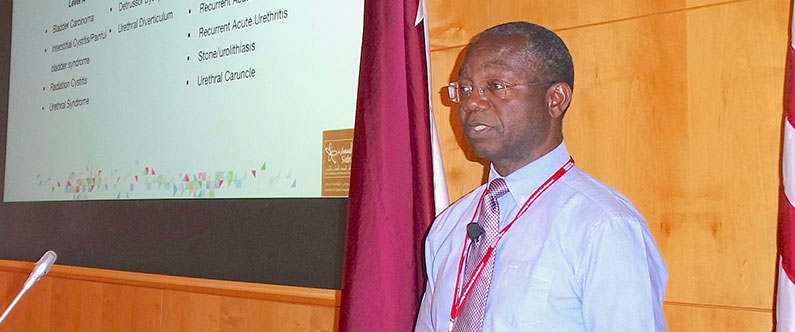Chronic pelvic pain explained at Grand Rounds
 Dr. Justin Konje of Sidra Medical and Research Center speaking at WCM-Q's Grand Rounds on the subject of chronic pelvic pain in women of reproductive age.
Dr. Justin Konje of Sidra Medical and Research Center speaking at WCM-Q's Grand Rounds on the subject of chronic pelvic pain in women of reproductive age.
Dr. Justin Konje, professor of Obstetrics and Gynecology at Sidra Medical and Research Center, described the various causes of chronic pelvic pain in women of reproductive age at the last Grand Rounds of the season.
Dr. Konje said studies in the US and the UK have indicated that chronic pelvic pain affects between 15 and 20 percent of women of reproductive age. It accounts for a fifth of all laparoscopies that are performed and for 12 to 18 percent of all hysterectomies carried out in the UK, US, Canada and Europe.
Chronic pelvic pain is a complex condition that can have many causes, such as endometriosis, chronic pelvic inflammatory disease, fibroids, irritable bowel syndrome, musculoskeletal problems and psychological issues.
In addition to being very unpleasant for those who have the condition, chronic pelvic pain has been estimated to carry an economic cost of around $3billion per year in the US in medical bills, plus a further $0.5billion in lost working hours.
Dr. Konje, who is also executive chair of the Women’s Services Clinical Management Group at Sidra, said: “In addition to being very difficult for the patient, chronic pelvic pain also has very significant implications for health and for the economy of every nation. It is as common as asthma, back pain and migraine and yet we invest a lot more money into those conditions. This is a serious medical issue that affects a lot of women and it should be recognized as such.”
Dr. Konje explained that in the UK, where he formerly practiced as a gynecologist, around 40-50 percent of women suffering with chronic pelvic pain have a history of abuse. Physicians treating chronic pelvic pain need to be aware of this factor, as well as many others, said Dr. Konje.
“Pain is complex to treat because it is perceived differently by different patients and is affected by many factors, such as age, emotional state, past or current abuse, family history, reproductive history, culture and so on.
“When treating pain the physician must make it clear to the patient that he or she understands and recognizes the pain. If the physician is very passive and does not acknowledge the pain adequately, that can negatively affect how the patient responds to the treatment that is offered.”
Dr. Konje also stressed the vital importance of making it clear to patients that the physician’s goal is not just to treat the symptom – i.e. the pain – but to identify its cause and treat that, too.
“Of course, patients want you to relieve their pain but they are also worried about what is causing the pain. Therefore, you must set up a mechanism to try to identify why the patient is having pain, reassure the patient, treat the pain and treat the cause of the pain,” he added.